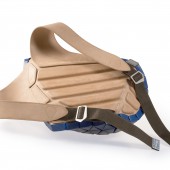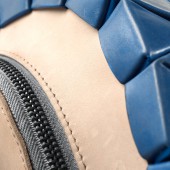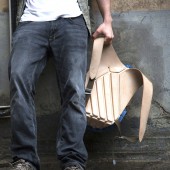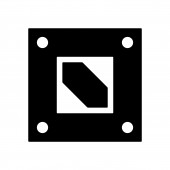Phoresy Pack Backpack by Stepan Pianykh |
Home > Winners > #157236 |
 |
|
||||
| DESIGN DETAILS | |||||
| DESIGN NAME: Phoresy Pack PRIMARY FUNCTION: Backpack INSPIRATION: The inspiration for this project came from the works of applied mathematicians like Ron Resch, who developed foldable tessellation patterns, and modern architects like Zaha Hadid, known for using computational design principles. The entire discipline of leatherworking and craftsmanship was a constant inspiration, guiding every detail. In terms of specific backpacks, I drew inspiration from the Meiosis backpack by Davidi Gilad and the Solid Gray backpack UNIQUE PROPERTIES / PROJECT DESCRIPTION: Phoresy Pack Is an ergonomic backpack design based on a unique flexible tessellated material. Produced from a single sheet of precisely CNC-milled and folded genuine leather, Phoresy Pack’s structure expands and shrinks flat based on the volume of its contents. While the final outcome of the project is merely a backpack, the aim of the project was to explore applications of parametric design principles in the fields of fashion and industrial design. OPERATION / FLOW / INTERACTION: Despite its transformative properties, the backpack operates in a straightforward manner. It features a single large compartment that, thanks to the elastic properties of the backpack's shell, naturally expands and contracts to accommodate the volume of its contents. PROJECT DURATION AND LOCATION: This project served as Stepan’s degree thesis, taking one semester for completion. Initiated in February 2015, it reached fruition by June of the same year. Following its completion, the Phoresy Pack made its debut at the degree show, the End of the Year exhibition at the British Higher School of Art and Design. Subsequently, the design gained recognition through participation in multiple exhibitions, such as: "Faces and Laces" 2015 "Uno" at Center MARS 2018 "Design Next" at the Central House of Artists 2018 Printed features included an appearance in Esquire Russia (July 2015 issue) and inclusion in the book "Ergonomics in Product Design" by SendPoints in 2018. Furthermore, the design has been showcased in various online publications, including YankoDesign, Designboom, and others." |
PRODUCTION / REALIZATION TECHNOLOGY: The Phoresy Pack is crafted from various types of natural cowhide leather. The back shell is constructed using blue-dyed leather milled on a CNC router, creating a crease pattern for folding and subsequent stitching on the sides. To add elasticity and enable the bag to fold flat when not filled, a separate layer of Spandex is integrated into the shell. The glossy finish on the leather is achieved through a special varnish, making it non-breathable and watertight. This varnish was crucial to ensure perfect adhesion of the leather sheet to the vacuum table during the milling process, preventing damage to the leather caused by gaps between the material and the table. Initially considering plastic/rubber, we opted for leather due to its superior tactile properties. The front side of the backpack incorporates traditional leather-working techniques, including leather forming, die-cutting, and sewing, to enhance comfort against the user's body. Design accessories like buckles are crafted from CNC-milled aluminum, while minor engravings on the bag's surface are created using a Laser Cutter. The cushioning on the front side is filled with soft cork pieces. SPECIFICATIONS / TECHNICAL PROPERTIES: This backpack is of average size, with approximate dimensions of 500 x 320 x 200 mm, offering a total volume of 15 liters. When empty, the backpack compresses to a smaller, flatter size. TAGS: Backpack, Fashion, Wearable, Computational Design, Leather RESEARCH ABSTRACT: This project combined design and market research to improve backpack functionality, emphasizing ergonomic principles and innovative materials. Utilizing literature reviews, user feedback, expert interviews, and iterative prototyping, it successfully implemented foldable tessellation patterns for adaptability and comfort. The impact reached exhibitions and publications, shaping societal perspectives on technology and craftsmanship in design. CHALLENGE: The most challenging aspects of the project involved the unconventional production techniques employed to bring it to fruition. While some leatherworking techniques adhered to traditional and well-documented craft methodologies, others, such as CNC milling cowhide leather, had to be developed during the project's evolution. One notable feature of the design, wherein the backside is crafted from a single sheet of leather, meant that any significant defect in the manufacturing stage required redoing an entire half of the backpack. This resulted in a highly iterative prototyping process. Additional challenges, like mastering the appropriate software for the project—specifical ADDED DATE: 2024-01-23 13:42:28 TEAM MEMBERS (1) : IMAGE CREDITS: Image #1: Photographer Timofey Sherstennikov, 2015. Image #2: Photographer Timofey Sherstennikov, 2015. Image #3: Photographer Timofey Sherstennikov, 2015. Image #4: Photographer Renata Garipova, 2015. Image #5: Photographer Renata Garipova, 2015. |
||||
| Visit the following page to learn more: https://drunks.st/ | |||||
| AWARD DETAILS | |
 |
Phoresy Pack Backpack by Stepan Pianykh is Winner in Generative, Algorithmic, Parametric and AI-Assisted Design Category, 2023 - 2024.· Press Members: Login or Register to request an exclusive interview with Stepan Pianykh. · Click here to register inorder to view the profile and other works by Stepan Pianykh. |
| SOCIAL |
| + Add to Likes / Favorites | Send to My Email | Comment | Testimonials | View Press-Release | Press Kit |







